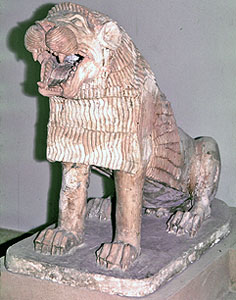HIS 111
Unit 3: Ancient Near East
 |
Ancient
Babylonian Lion Statue; fierce not gentle; ready to rip you to shreds not take a nap; photo courtesy C. Wayne and
Dorothy Miller (my wife's grandparents). I have some other photos
of Baghdad for you to look at. All of these were taken in the
mid-1960s, long before the troubles that beset the Iraqis.
|
 What you must do in this unit
What you can do in this unit
What you must do in this unit
What you can do in this unit
- Listen to some further information for this unit
as a mp3 file. You can also read the information as
a txt file.
- You may listen to some further information about the Ancient
Near East from
my HIS 101 course.
- Review my notes and remarks on the Ancient Hebrews and the development of the idea of ethical monotheism from my HIS 101 course.
- Exploring Ancient
World Cultures is a very large website that includes very interesting resources on these ancient
societies: India, Greece, Rome,
Egypt, China, the Near East and Early Islam.
- Please read the Sample Historical
Document Analysis,
based on some excerpts from Hammurabi's code of law. The sample illustrates some of the questions
that a historian asks when reading a historical document. This is what you will be doing in this course.
Some videos that you can watch for this unit
- See the videos dealing with the Ancient Near East in the HIS 101 course.
- For extra credit please suggest to your instructor a relevant video for this unit of the course. Send the title of the video, the url and a brief explanation of why you find the video interesting and applicable to the material that is being studied in this unit.
Extra Credit Options
- Take the short 5-point quiz for chapter 2. Log into Blackboard and look under "Chapter Quizzes." You have five minutes to complete each quiz (multiple-choice questions).
- Write a one-page paper (maybe
two pages if they are exceptional) that provides a detailed comparison of
Gilgamesh and Genesis (You may wish to read more
of Genesis for your comparison.) for a maximum of 50 points.
- For
25 points maximum extra credit, read Hammurabi's Code of Laws and write a paragraph explaining the social structure of Ancient Babylon.
- For
25 points maximum extra credit, read
The Precepts of Ptah-Hotep, c. 2200 bce,
and write a paragraph explaining Ptah-Hotep's understanding of how to live one's life.
- For
25 points maximum extra credit, read the Genesis excerpt and write a paragraph answering this question, Did Genesis describe
an ethical religion, i.e. a religion that demanded moral behavior?
- For extra credit of a maximum of ten points,
you can submit the answers to the Gilgamesh study questions. Please write in formal, complete sentences.
- For extra credit, please suggest a
relevant website for this unit of the course. Send the title of the site, the url and a
brief explanation why you find the information interesting and applicable to
the material being studied this unit.
|

